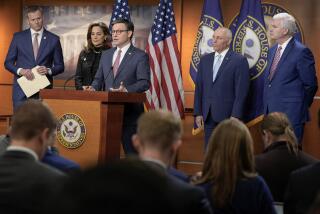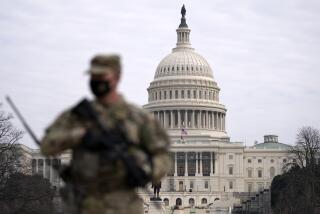A sharp focus on democracy
- Share via
Absent an unexpected groundswell of opposition, Congress this week will pass legislation that gives the Defense Department the authority to suppress evidence of its own misconduct.
The legislation -- originally proposed by Sen. Joe Lieberman (I-Conn.) -- is an amendment to the 2009 Homeland Security appropriations bill that was passed by the House and is headed for a final vote on the Senate floor. The amendment is aimed at a 2008 appeals court decision requiring the Defense Department to release photographs showing Afghan and Iraqi prisoners being abused and in some cases tortured by U.S. military personnel. Its ramifications will be sweeping and will extend far beyond the specific lawsuit it is meant to quash.
The amendment is directed at a lawsuit filed by the American Civil Liberties Union to enforce a Freedom of Information Act request submitted in 2003. After a court ordered the Bush administration to respond to the request, the Defense Department acknowledged the existence of the prisoner-abuse photos but sought to withhold them from the public on the grounds that their disclosure could provoke violence against U.S. troops and others in Afghanistan and Iraq.
A federal District Court rejected that argument, and a unanimous three-judge panel affirmed that decision, reasoning that a generalized and speculative fear of violence was insufficient to justify the photos’ suppression. The Obama administration, after first saying that it would release the photos, changed course and appealed to the Supreme Court, which is slated to decide this month whether to hear the case.
The legislation is meant to substitute Congress’ judgment for that of the courts. Of course, the FOIA is a statute, not a constitutional provision, and Congress has the authority to amend the statute if it wants to. It is extraordinary, however, for Congress to attempt through legislation to control the outcome of individual cases. Its effort to do so here is especially disturbing because, as the appeals court noted, the release of the photos is consistent not only with the language of the FOIA -- language that Congress is now poised to revise -- but with the broader principles underlying that statute.
The basic purpose of the FOIA, the Supreme Court has previously recognized, is “to ensure an informed citizenry, vital to the functioning of a democratic society, needed to check against corruption and to hold the governors accountable to the governed.” As the appeals court in the current case observed, the photos “place government accountability at the center of the dispute.”
Their release would allow the public to understand better what took place in the military’s detention centers, and why. They might show patterns that have until now gone unnoticed, and they would surely convey, better than mere text ever could, the cruelty of such practices as stress positions, hooding and mock executions. And disclosure of the photos might also spur calls for a more thorough investigation into prisoner abuse than has been conducted thus far.
The fear that the country’s enemies will use the photos as propaganda is not baseless, but it is a mistake to give violent extremists a veto over the FOIA. The argument that the government has made in court -- and that animates the proposed legislation -- would give the greatest protection from disclosure to records that relate to the worst governmental misconduct, because it is those records that are most likely to be inflammatory. Suppressing such records might deprive the country’s enemies of propaganda, but it would also deprive the American public of information that is crucial to the democratic process.
The legislation would suppress many more photos in government custody than the ones at issue in the ACLU case. It covers images taken between Sept. 11, 2001, and Jan. 22, 2009, that relate to the treatment of individuals “engaged, captured or detained” by the armed forces. It would cover photos depicting the abuse of prisoners, but it could also cover, for example, video footage of aerial attacks that resulted in civilian casualties or photos showing the conditions of confinement at the Bagram detention center in Afghanistan. The legislation establishes a regime of censorship that would extend to many images of the military’s activities abroad.
The legislation does include what may at first appear to be a silver lining. Rather than categorically exempt images from the FOIA, it invests the secretary of Defense with the authority to exempt photos. This creates the possibility that the secretary could decide to release some photos that the legislation gives him the authority to suppress.
In the end, however, the fact that the secretary could select which images to release and which to suppress may only deepen the proposed legislation’s invidiousness. Consider the possibility that the secretary, invoking his authority under new legislation, withholds half of the prisoner-abuse photos. How should we interpret the photos that are disclosed? What conclusions can we fairly draw about the kinds of abuses that were inflicted on prisoners, or the Defense Department’s responsibility for that abuse, when the secretary of Defense has chosen which images the public is entitled to see? The legislation almost certainly will deprive us of information we would otherwise have had access to, but its even more nefarious effect will be to corrode the integrity of the information we can still obtain.
Supporters of the legislation have said that the bill is motivated by concerns about security, but no democracy has ever been made stronger by concealing evidence of its wrongdoing. The last administration’s decision to endorse torture undermined the United States’ moral authority and compromised its security. The failure of the country’s current leadership to fully confront the abuses of the last administration -- a failure embodied by the legislation that Congress is preparing to enact -- will only compound these harms.
More to Read
Get the L.A. Times Politics newsletter
Deeply reported insights into legislation, politics and policy from Sacramento, Washington and beyond. In your inbox twice per week.
You may occasionally receive promotional content from the Los Angeles Times.









